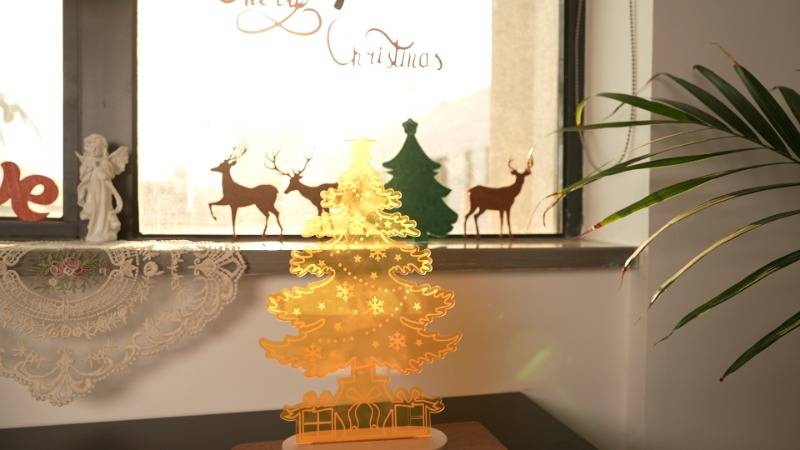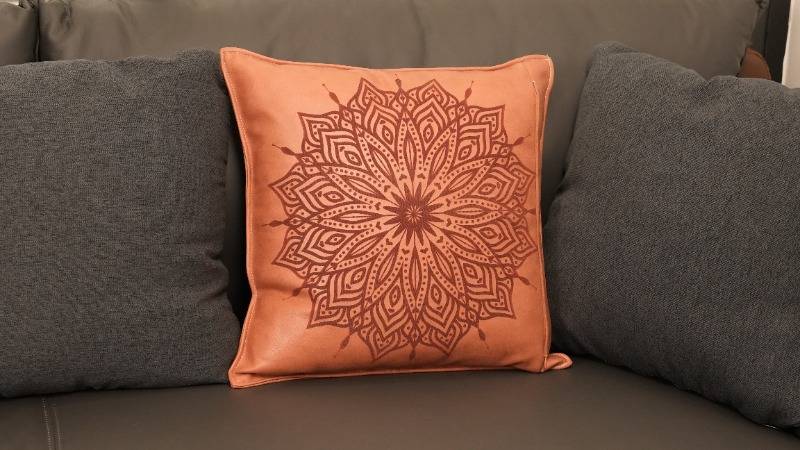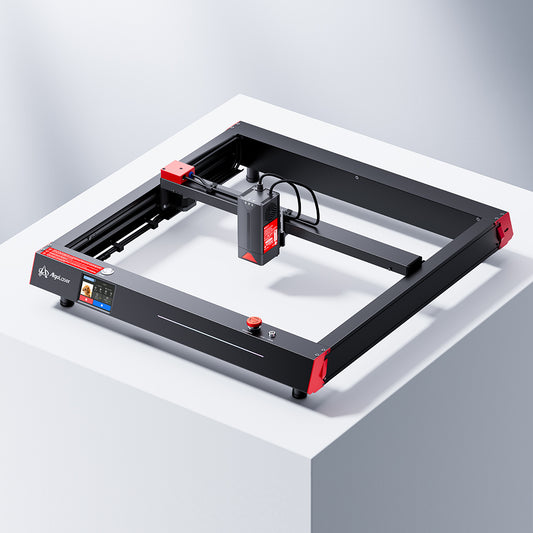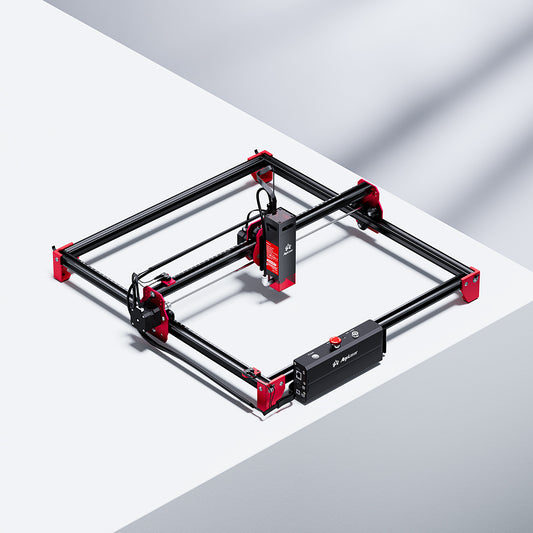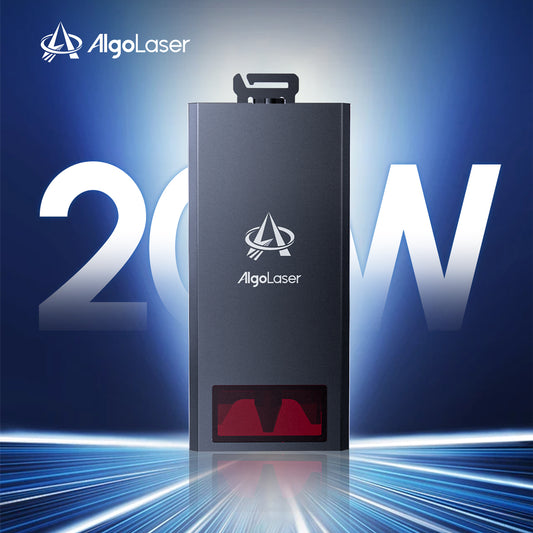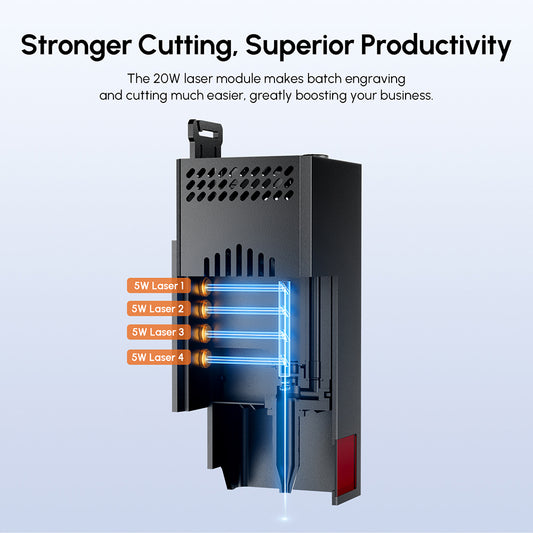Diode Laser Engraving Metal
Metal Engraving With a Diode Laser Engraver
1064 Module Laser vs. Diode Laser vs. Traditional Metal Engraving
| Parameter | 1064 nm Module (fiber / DPSS / solid-state) | Diode Laser | Traditional Metal Engraving* |
|---|---|---|---|
| Wavelength | ~1,064 nm | often 445 nm | n/a (mechanical or chemical, not optical) |
| Beam quality / M² | ~1–1.5 (very good) to ~2–3 (multimode) | Worse: M² maybe 2–6 or more | Not applicable; mechanical tool size / bit geometry |
| Spot size (typical) | 20–50 µm or even smaller (e.g. 0.03 mm = 30 µm) — e.g. the LASER TREE 1064 module claims 0.03 mm spot size (LASER TREE) | Often 50–150 µm or more, depending on optics | Mechanical bit tip dimension, often 100–300 µm or more depending on tool |
| Power / output | 0.5 W – 100 W+ (for industrial fiber lasers); small modules often 1–5 W | 0.5 W – 30 W (desktop/hobby class) | No “laser power” — instead you have spindle power or chemical flux |
| Typical depth per pass (on steel / stainless) | Tens of microns (0.01–0.1 mm) in one pass; deeper with multiple passes | Very shallow — often surface marking / light engraving; microns scale | Mechanical: can carve deep grooves (0.1 mm to mm+); chemical: can etch tens to hundreds µm (depending on time) |
| Throughput / speed | High speed due to high power and good coupling | Moderate; slower for same depth | Mechanical: limited by tool speed and advance; chemical: slow, must soak |
| Heat-affected zone / recast / microcracks | Present but can be minimized by pulsed mode, proper settings | Excess heat may cause material warping | Mechanical: minimal thermal damage (unless using heat, e.g. laser-assisted mechanical); chemical: depends on mask and etch scheme |
| Material compatibility | Can directly engrave many metals (steel, SS, aluminum, copper, gold, etc.) | Often limited: good on coated metals, anodized metals, or requiring marking spray on bare metals (Laserax) | Mechanical: any machinable metal; chemical: metals that respond to etchants (copper, brass, mild steel, etc.) |
| Maintenance / consumables | Low (fiber modules are robust, minimal parts) | Moderate — diode lifetime, optics, cooling | Mechanical: bit wear, coolant, tool replacement; chemical: acids, masks, cleaning |
| Capital & operational cost | High (industrial fiber systems are expensive) | Low-to-moderate | Mechanical: medium (machine, tooling); chemical: cost of chemicals, safety handling |
| Precision & repeatability | Excellent (fine detail, repeatable) | Good for many hobby / small business uses | Mechanical: high precision possible, but tool deflection and wear matter; chemical: good for fine masks if well done |
| Setup / alignment complexity | Moderate to high (optics alignment, beam path) | Lower | Mechanical: moderate (tool paths, fixturing); chemical: lower but requires masking / cleaning setup |
| Environmental / safety concerns | Laser safety, ventilation for fumes / smoke | Laser safety, ventilation | Mechanical: chips, coolant, noise; chemical: hazardous chemicals, disposal, fumes |
1064nm Laser Module – Precision Engraving for Metal & More!
Types of metals that can be engraved with 1064 nm
| Metal / Alloy | Engraving behavior / Comments | Challenges / Notes |
|---|---|---|
| Stainless Steel | Common target. Can be ablated or removed surface oxide/coating to create contrast. Many fiber/1064 systems list stainless steel explicitly. | Its thermal conductivity is moderate; heat diffusion can soften edges or widen lines. Reflectivity is moderate in NIR, so efficient coupling is needed. |
| Mild Steel / Carbon Steel / Tool Steel | Good absorption; easier to mark. | The oxidation / burning / heat-affected zone must be controlled, or edges may discolor. |
| Aluminum & Aluminum Alloys | Engravable, especially when oxidized or coated; can remove anodization or produce contrast by oxidation. | Pure aluminum is reflective and highly thermally conductive, so getting enough localized energy can be harder. The risk is "blanching" or over-oxidation. |
| Copper / Brass / Bronze | These are often marked by 1064 systems. Copper is more reflective, but brass/bronze (with alloying) is easier. | Copper's high thermal conductivity and reflectivity make it more challenging — you need high peak power, small spot, and perhaps multiple passes. |
| Titanium / Titanium Alloys | Can be marked, especially for contrast (oxidative coloration, etc.). Some modules claim support for titanium. | Thermal conduction is lower than copper but surface films / alloys may influence absorption. |
| Precious Metals (Gold, Silver, Platinum) | Very common in jewelry marking. Many "1064 modules" specifically mention gold, silver, platinum engraving. | These metals are usually shiny and reflective, so a clean, optimized focus and pulse control are essential. Sometimes the marking is via surface oxidation or micro‐ablation rather than deep cuts. |
| Coated / Anodized / Painted Metals | One mode is removing the coating (e.g. anodization, paint, powder coating) to reveal the underlying metal, thereby creating a contrast mark. | This is often easier than engraving pure metal; the risk is damaging the substrate or delamination. |
| Nickel, Chromium, Nickel Alloys, Inconel, etc. | These harder / higher alloy metals can be marked, in industrial fiber systems. The 1064 wavelength generally couples well to many alloys. | More refractory alloys may require higher power, longer dwell, or multiple passes. Heat-affected zones and oxidation must be managed. |
Mapping the Datasheet to Engraving Capabilities (for Metals)
| Capability | Likely Outcome | Constraints / Risks |
|---|---|---|
| Thin surface marking, contrast engraving | Good. You can remove thin surface oxide, coatings, or produce surface contrast marks (e.g. blackening, roughening) on many metals. | Depth will be shallow. Too much power may cause melting, burr, or microcracking. |
| Fine detail, line work | Achievable, thanks to small spot (~30 µm). Good for jewelry, codes, logos, serials. | Focus, vibration, backlash, and Z flatness become critical. |
| Shading / grayscale on metal surfaces | To some extent possible (micro-ablation or variable removal) — test results on copper show some subtle variation. | Uniformity is harder; repeated passes may heat the part. |
| Cutting / penetrating metals | Very limited. Probably only ultrathin metal foils (≈ 0.01–0.05 mm) under ideal conditions, if at all. | Thermal diffusion, high reflectivity, and limited power cap this severely. |
| Engraving on high-conductivity / reflective metals (e.g. copper, aluminum) | It works, but with more difficulty. You'll need tighter focus, slower speeds, more passes, maybe lower beam divergence. | Because conductivity & reflectivity are high, heat spreads quickly and much of the beam may reflect. |
| Consistency across large areas | Possible, but challenging. You'll need calibration, test passes, and perhaps overlapping scan strategies. | Beam profile nonuniformity, drift, and differences in surface condition can cause variations. |
Engraving Made Simple!
Print directly to your laser from any graphics software.
1. Choosing a Design Blueprint: Select your design or blueprint to work on.
2. Material Settings: Set the machine according to the material being used by adjusting speed and power settings as specified for the material.
3. Steps for Operating a Diode Laser Engraving Machine with AlgoLaser 1064nm Infrared Laser Module:
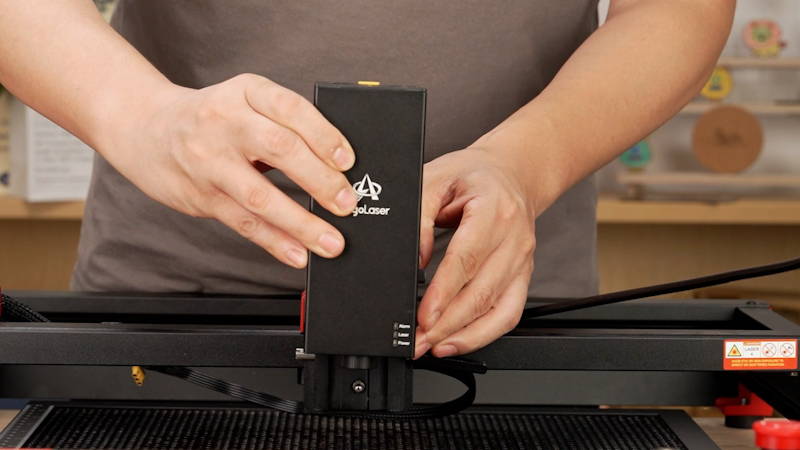
Step 1: Install the 1064nm Laser Module on the Alpha MK2
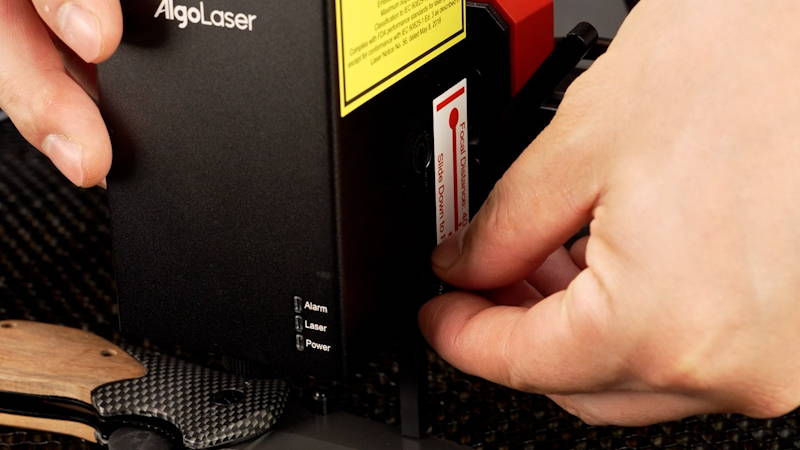
Step 2: Secure the Knife & Adjust the Focal Length

Step 3: Upload Your Design and Configure Settings
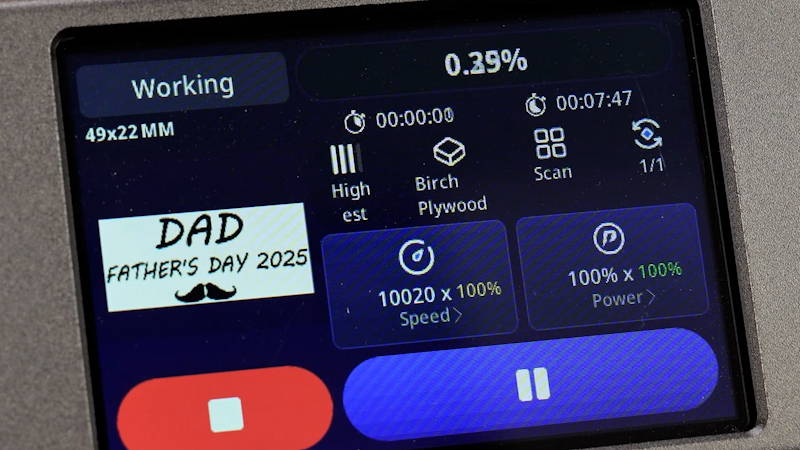
Step 4: Use the 20W Laser Module to Engrave Packaging or Wood Stand
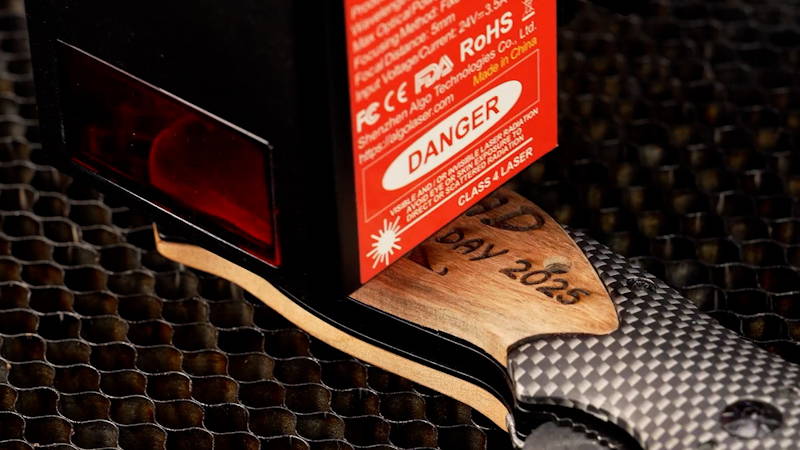
Step 5: Finishing Touches
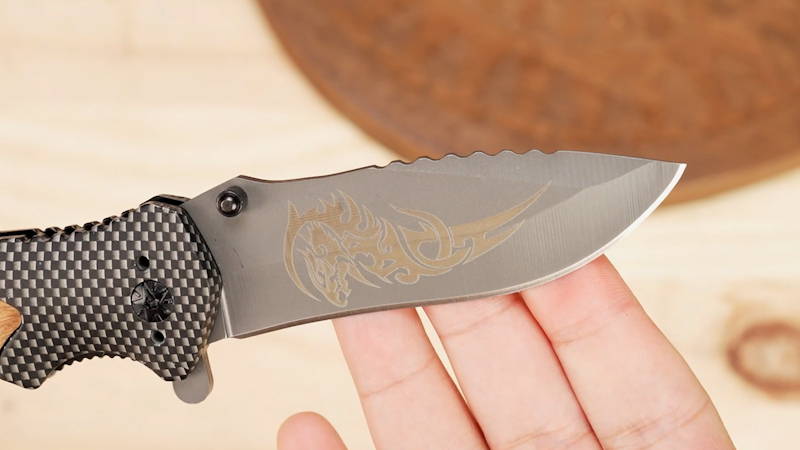
Step 6: Completed Laser Engraving Father's Day Metal Pocket Knife
The Sample Club — You May Also Like…
Get fresh project inspiration every month with step-by-step guides and free SVG & G-code files for all your laser engraving and cutting projects!
Related to: Metal
How to laser engrave various materials?
Various projects and ideas about how laser engraving small business owners and freelance engravers use laser engravers and start a business.
Recommendations for Laser Engraving Machines
Whether you're working on single items or managing a heavy workload, an AlgoLaser Laser Engraver is the right solution. Check out our full product line for reliable and efficient engraving of Metals.








